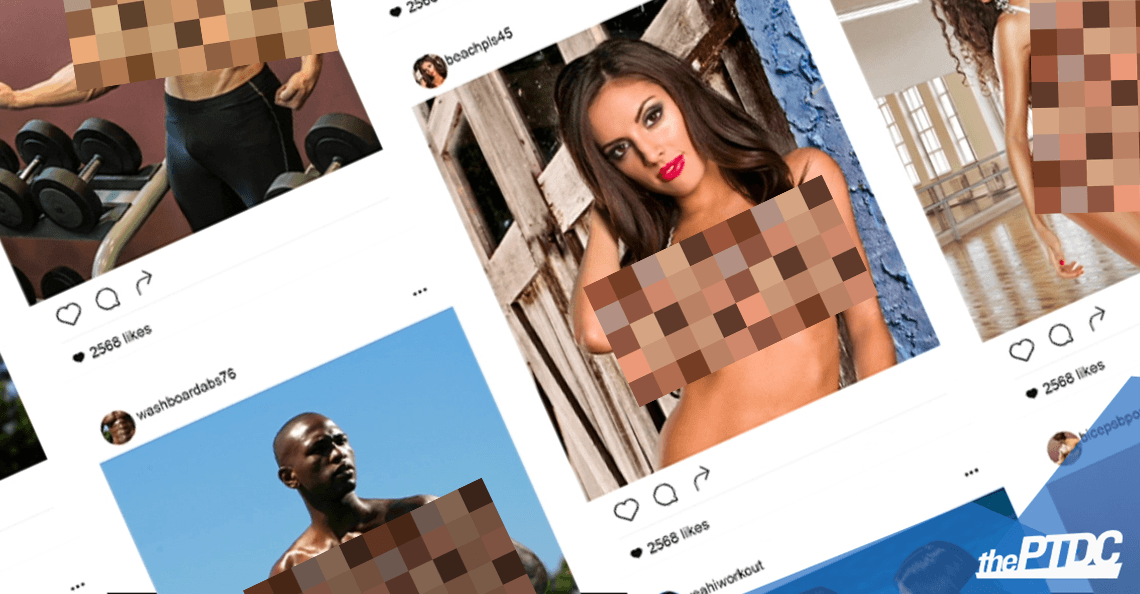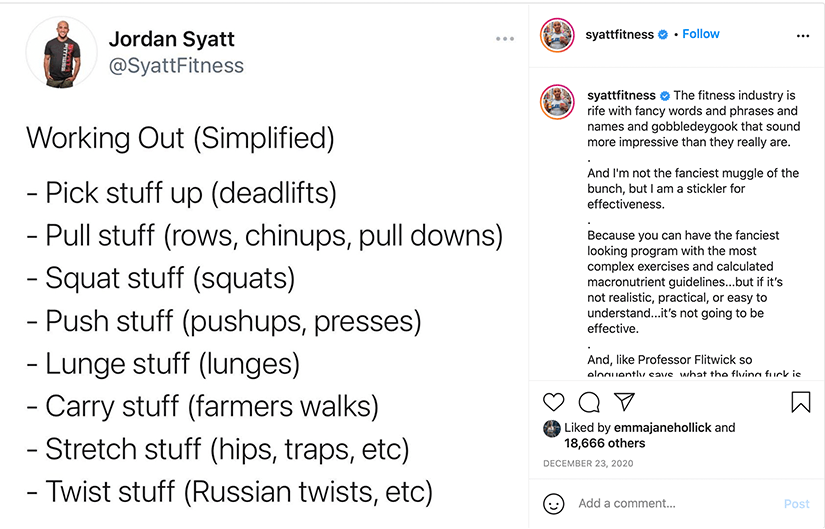You pause your scrolling at a photo of an “InstaTrainer,” all gleaming muscle and spandex. Lots of skin.
What’s your reaction? Awe? Envy? Discouragement?
All of the above would be understandable. But think about it—those reactions are probably useless to the personal trainer who posted it on Instagram. Because you’ll keep scrolling, right?
Now compare that post to one that makes you smile, laugh, or nod in recognition. One that makes you think, follow, share—and act.
That’s gold. Those are the posts you like to see, and they’re the kind you should be posting yourself.
Success on Instagram is like strength training—only consistent, smart work will pay off.
Lots of trainers have fear and anxiety over Instagram. But you don’t need gimmicks or skimpy clothes to succeed. I’m proof of that.
I’m an online personal trainer in Vancouver, with 66k loyal followers and a select group of online clients.
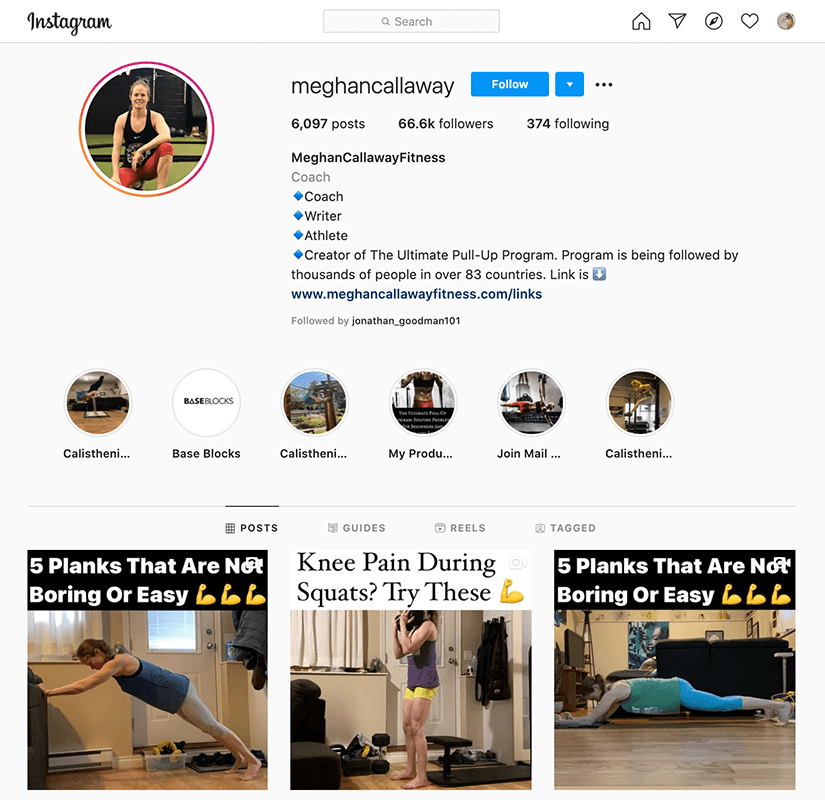
I run a thriving business selling extremely comprehensive programs on pull-ups, push-ups, and landmine exercises to thousands of athletes, coaches, and regular folks of all genders in over 100 countries worldwide.
(I also coached people in person for 17 years, 13.5 of which was full time.) That’s just the tip of the iceberg of what I have to offer.
My Instagram presence (@meghancallaway) is fairly unglamorous.
But it works for me, and my honest approach can work for you, too.
Warning: None of the advice I’m about to share will jumpstart anything or guarantee a breakthrough, because that’s not how this works.
I’m not flashy.
My videos are authentic and relatively unpolished—and my outfits are practical and comfortable.
They’re designed to showcase my content, not my aesthetics. (To be clear, I fully support people wearing whatever makes them feel happy and comfortable.)
Ver esta publicación en Instagram
My formula: comfortable clothes, less flash, more heart and substance. The result: devoted followers, clients, and customers.
Here’s what I’ve learned from trial and error, from watching others, and from asking colleagues.
How to promote personal training on Instagram: An eight-step guide for online personal trainers
Be your authentic self
No, you don’t have to spill every detail of your personal life.
But if you are real, your audience will relate to you.
With me, what you see is what you get. If you saw me online and then met me in person, we’re identical. (Although people think I’m much taller than I really am!)
People comment that they like I don’t play the popularity game.
Content and credibility as an athlete and coach are why people follow me. I’m sure it’s the same reason Samuel Spinelli has 362k followers—his posts are a model of clear, credible content.
Here’s the best part: Being authentic should take no effort at all. You’re just being yourself.
I’ve noticed some people trying hard to be authentic, and it shows. I don’t try—and that’s why I share lots of videos and photos of my cats and my own training progress. That’s just me.
Ignore “inspiration culture”
Part of being authentic and relating to your audience is turning away from all the in-your-face self-promotion out there.
Follow accounts with valuable information.
Honesty and transparency will be rewarded. Flashy and phony resonates with nobody. Besides, it’s disrespectful to your audience.
A great example of an authentic (and fun) account is Sohee Lee, who includes valuable information in her educational and sometimes funny posts. Her honesty shines through, and her audience appreciates that.
Ver esta publicación en Instagram
Tell your story
Twelve years ago, I was in a bad car crash.
Took me years to overcome some weird, sometimes debilitating, and physically and mentally exhausting symptoms and rebuild my body. Focusing on the pull-up was a big part of that.
(Sidenote: So was Stuart McGill, Ph.D., the renowned back-pain expert. If you haven’t already, you owe it to yourself and your clients to check out his work.)
That’s my story. I’m an athlete (decades of soccer) who had to relearn basic movements. Now basic movements form the basis of my coaching, content, and products.
Too many online personal trainers let their business pitch obscure their personal profile.
If you’re personal on Instagram, it’ll help your business.
Ask yourself: What makes you unique?
I enjoy Kirsty Grosart’s Instagram account and her story, which is summarized in her handle, garagegymgirl, and her bio, “gymnast turned bodyweight strength coach.” (Her cat often joins in when she's performing incredibly difficult calisthenics exercises. What's better than that?!)
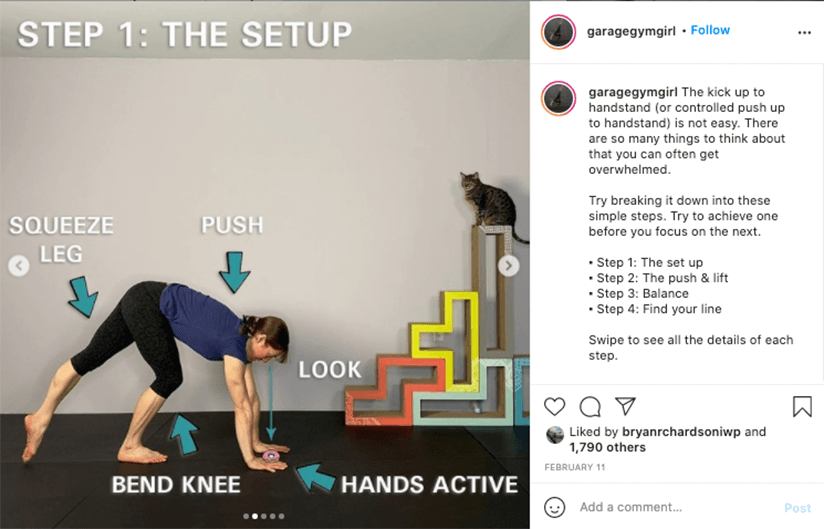
As for me, I’m known for innovative yet commonsense approaches to fundamental exercises. I’m not being creative for the sake of creativity.
My approach shows that if you really focus on becoming proficient at the fundamentals, the possibilities are endless.
I’ve had to overcome a lot. I think I’m a great example of how effective this approach is. This is what I focus on with my clients, and also in my products and content.
I’ve told my story on podcasts and in my blog, and it sets me apart. Telling your story helps you find your niche—and helps others find you.
Go with what works—and stick to it
Here’s where the analogy with training is undeniable. People overcomplicate things in the gym and on Insta. They jump from one thing to another in their workouts and on social.
They wish for a quick spike in followers and for quick gains in the gym.
The key, of course, is consistency. And it’s clear the Instagram algorithm likes consistency.
A model of that approach is Jenni Rawlings, whose knowledge of yoga and movement comes through clearly and, well, consistently.
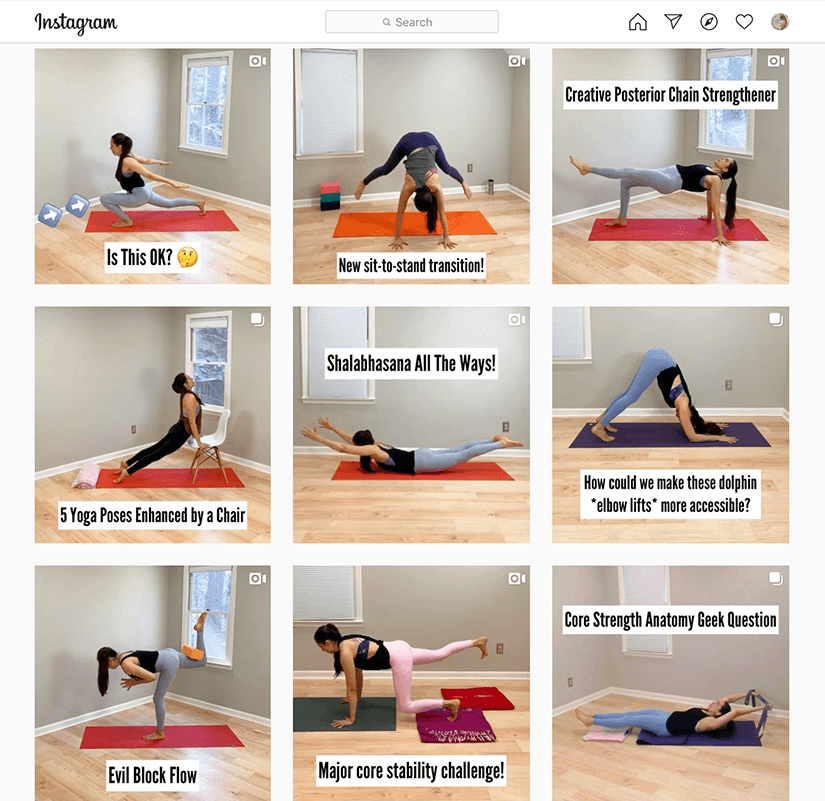
Don’t be afraid to recycle content. It’s not cheating, it’s smart!
If something is vital, it bears repeating. Think about it: When you’re coaching, you don’t just say something once.
How frequently? A few years ago, the experts were claiming you had to post two or three times a day to get traction. But people were churning out poor or mediocre content with no rhyme or reason.
I post twice a day and this works well for me. Determine what works best for you, and what’s practical.
Just remember that it has to be consistent quality, not just something you throw on there on the spur of the moment because you realize you haven’t posted yet today. Go with whatever cadence allows you to do that, whether it’s once a day or several times per week.
The past couple of years, I’ve been doing weekly features, five exercises on a certain topic (like stronger hammies), and share a different exercise each day. Then a carousel summing it all up on Saturday.
My audience responds, so I stick with it.
Apply the “three E’s”
The Instagram ecosystem is fascinating, but don’t get dazzled. Simply apply rigorous standards to everything you post or share. Use my test, where “E” is a great grade.
Educate. Are you teaching something valuable? Is the information clear and digestible? Do viewers understand what your content can accomplish, and why your tips work?
Empower. Is your content going to make your viewer feel confident? Will your post make them feel good about training and great about themselves?
Excite. Does your post convey the thrill of seeing something (an exercise, a concept) in a fresh way that compels them to use it in their lives?
If you can hit two of those three, a post is likely to do well. If you get all three, the chances are better it will explode.
Most of my marketing is free—it’s other people sharing and tagging and talking about something I’ve put up and the programs I’ve created. But they won’t do that if it isn’t of high quality.
I make sure my exercise descriptions, even on Instagram, are detailed. I want readers to truly understand what I’m sharing, as if I’m there with them in person.
For example, one of my descriptions for a band exercise for runners goes on for 260 words, with specific cues and tips.
Someone who manages to hit all three E’s on a consistent basis is Luka Hocevar. His demonstrations and educational content will have you reaching for the nearest kettlebell.
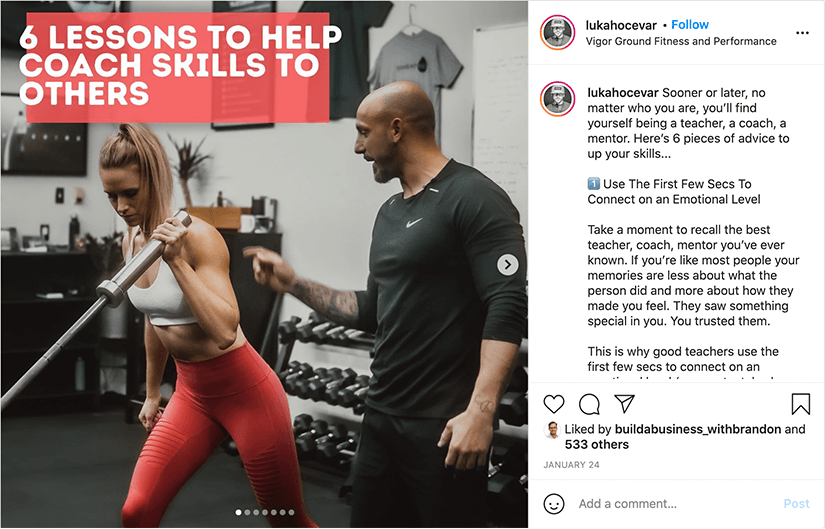
Sometimes you’ll post something you’re sure will explode. But it’s a dud. Other times the opposite occurs: An everyday post takes off.
That’s one reason to keep plugging away—some of your posts will do great, and you should look for what they have in common.
Focus on the right things
Lots of trainers obsess over likes, views, and follows. But what matters far more is how many people share your post or save your post. That shows clear interest in your content.
An Instagram business account (it’s free, and you can convert a personal account to business) lets you track your stats by clicking on “Insights.” You’ll get a clearer picture of your reach, how many new followers a post generated, how many views, shares, and saves.
You’ll also see how well your group of hashtags performed.
Again, shares and saves are most important.
I can hear you asking: Are hashtags important? Yes and no. In the past year, I sense (and have heard) that they’re becoming less effective. If a hashtag performs well, that’s a bonus.
Too many personal trainers slap hashtags on posts without thinking. They’ll even just copy-and-paste a set of tags that they’ve used in the past on countless other posts. Bad idea.
Your hashtags have to be relevant.
They should be related to the post and hit a sweet spot between generic and specific.
If a hashtag is too popular, the post will get buried amid millions of others. If it’s too specific, few people might search for it.
I’m not an expert with hashtags, but I experiment a lot. It only takes a few minutes to think about it, and it’ll pay off.
Share from the best
First things first: Always give credit where credit is due.
Besides being the right thing to do, crediting others may well lead to them sharing your posts, leading viewers back to you. (Just don’t forget to tag them in the post so they’ll see it!)
I know what works for my audience. So I share the best stuff that fits my game plan, and sometimes I’ll incorporate great nuggets from others into my own posts.
Make sure to follow people in our industry who you respect and admire. I make a point of only following people who are good human beings. This is important to me.
You’ll learn a lot, of course, and they might follow you back and engage with you. This can help grow your audience and drive people to your content.
Remember, it’s a two-way street. Engage with the posts of the awesome people you find and share the good stuff. You’ll help each other.
Powerlifter and trainer Jordan Syatt (@syattfitness) is all-world in audience engagement. Check out his posts and you’ll find valuable, clear information on a consistent basis.
Two things he’s constantly doing: writing and reaching out to others in any way possible. The more you write, the better you’ll get, and the bigger your archive of content becomes. The more people you contact and learn from, the smarter your posts will be.
And I love that Jordan doesn't take himself too seriously, as far too many in the industry do.
Follow accounts that are doing well and that you enjoy. Take note of what they’re doing, in our industry or elsewhere.
Plan smart
Lots of people cook ahead—make something on Sunday that’ll be good for meals later in the week. I do that with my social media content.
You should set aside time to do it right. This helps with quality, consistency—and peace of mind. I schedule a block of time to mass-produce videos and exercise descriptions.
I’ll never toss something out there that’s half-baked. That would affect my credibility and erode trust with my loyal followers and customers, and respected coaches in the fitness industry. My personal and professional reputations matter a lot.
With my system, I could easily put up three posts a day, though twice a day is working for me.
If you devote a regular chunk of time to producing content, you’ll build an archive that’ll serve you well for months and years to come.


